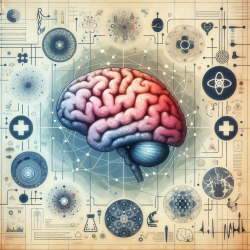Introduction
Autism Spectrum Disorder (ASD) presents unique challenges in understanding brain development and function. Recent research, such as the study titled "Developmental pattern of the cortical topology in high-functioning individuals with autism spectrum disorder" by Zheng et al., offers valuable insights into the cortical topology of individuals with ASD. This blog aims to help practitioners improve their skills by applying the findings of this research or encouraging further exploration.
Understanding Cortical Topology in ASD
The study by Zheng et al. investigates how ASD influences the topological organization of the brain cortex across different developmental stages. Using structural images from the Autism Brain Imaging Data Exchange database, the research analyzed 492 high-functioning participants, including autistic children, adolescents, and young adults, alongside typically developing controls. Key findings include:
- Reduced small-worldness in the network of surface area (SA) in autistic children.
- Reorganization of network hubs in adulthood, with hubs connecting more with non-hub nodes.
- Increased segregation of the inferior parietal lobule, prefrontal cortex, and insular-opercular cortex, resulting in unique modules in the autistic brain.
Implications for Practitioners
Understanding these developmental patterns can significantly enhance the ability of practitioners to support individuals with ASD. Here are some ways practitioners can apply these insights:
- Tailored Interventions: Recognizing the changes in cortical topology can guide the development of age-specific interventions that address the unique cognitive and social challenges faced by individuals with ASD.
- Enhanced Diagnosis: Incorporating cortical topology analysis into diagnostic processes can lead to more accurate and earlier identification of ASD, allowing for timely interventions.
- Collaborative Research: Practitioners are encouraged to collaborate with researchers to further explore the implications of cortical topology changes, contributing to a more comprehensive understanding of ASD.
Encouraging Further Research
The findings of this study open up numerous avenues for further research. Practitioners can play a pivotal role in this process by:
- Participating in Studies: Engaging in research studies can provide practitioners with firsthand experience of the latest methodologies and findings.
- Sharing Observations: Practitioners can contribute valuable clinical observations that may inspire new research questions or hypotheses.
- Advocating for Funding: Supporting funding initiatives for research into cortical topology and ASD can accelerate the development of innovative therapeutic approaches.
Conclusion
The developmental trajectory of cortical topology in individuals with ASD is a promising area of research that holds potential for improving therapeutic strategies. By understanding and applying these findings, practitioners can enhance their skills and contribute to the evolving landscape of ASD treatment and research.
To read the original research paper, please follow this link: Developmental pattern of the cortical topology in high-functioning individuals with autism spectrum disorder.










